How to connect a twisted pair cable to each other: methods + instructions for building up a twisted wire
Wired Internet connection is considered more reliable than switching devices via Wi-Fi. Twisted pair stably transmits a signal, despite the distances and interference, which are often critical for a wireless network.
Sometimes you need to lengthen or repair the Internet cable, and there is no time to wait for the arrival of the master. Agree, in this case, the ability to increase the network cable yourself is useful.
We suggest figuring out how to connect a twisted pair cable to each other, which method is the most reliable, and which method is suitable as a temporary solution.
The content of the article:
Reasons to build a twisted pair
The most likely reason to increase the length network cable - transfer of a laptop or stationary PC to the back room.
At a great distance in an apartment with reinforced concrete walls and ceilings, the signal weakens, and it becomes problematic to take lessons or prepare a project.
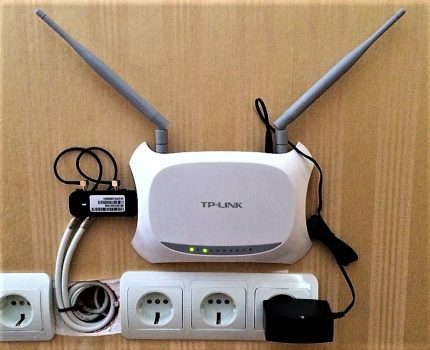
The second reason is related to repair. If the twisted pair is not sewn under the drywall or in the baseboard, but lies on the floor, not protected by anything, then it is easy to damage it. This can be done with a chair leg or a door.
Often, small children or animals “help” break the cable - the former by chance, and the latter for some reason are very fond of nibbling unattended, unattended cords.
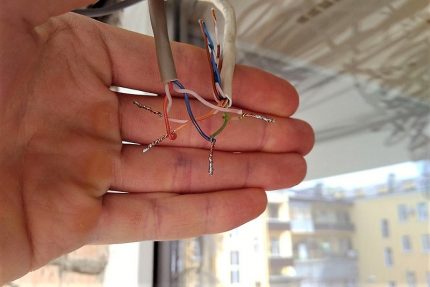
Thrifty owners of computer equipment do not buy long cables if you have a few short cables at hand. Some manage to assemble an almost 6-meter functioning cable from 3 two-meter segments.
Internet wire connection methods
Consider 4 methods that can be called household.Some of them require the use of a special tool, others are performed almost manually. If all four instructions seem complicated to you, you can just go to the store and purchase a patch cord of the required length.
Option # 1 - twisting wires
If you have ever dealt with electrical wires, you are well aware of what twisting is. This compound lived for one purpose by twisting followed by isolation.
Twisting is used to distribute wires in junction boxes, when connecting switches and sockets, to connect a broken electrical circuit.
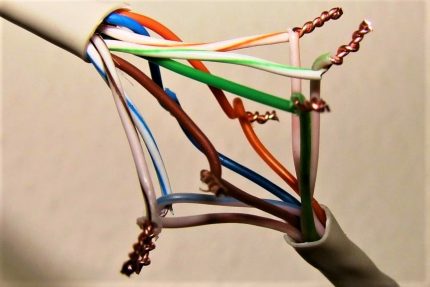
Of course, such a connection cannot be called effective, since negative consequences in the form of signal attenuation are possible. However, the wire will still remain operational and will fit for at least temporary use.
For work, we recommend preparing:
- a knife, scissors or a special tool for removing the braid;
- wire stripper;
- tin solder 0.3-0.5 mm;
- heat shrink 1.5 mm (after heating - 0.75 mm);
- matches;
- electrical tape.
Step-by-step instructions for twisting twisted pair:
If everything is done carefully, the shape of the cable will hardly change. Thanks to this, it can be pulled into the wall hole or closed into the baseboard.
But at the first opportunity, we recommend replacing the “reanimated” twisted pair cable with a factory-made solid wire. This is necessary both for safety and to ensure a stable signal.
Option # 2 - soldering
Ordinary Internet users are unlikely to have a soldering apparatus at hand and actively use it, so we recommend that soldering twisted pairs only to people who own the equipment.
This method could not be considered, but the connections after heat treatment are really reliable, and the cable is workable.
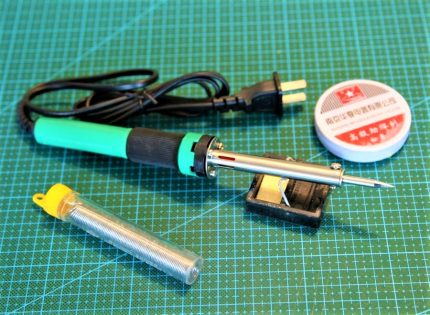
It is more convenient to work with a modern tool - a soldering iron with a display showing the heating temperature, or a stripper - a professional knife replacement.
Separate solder with a flux is best left to professionals, for lovers a combination wire has long been produced.
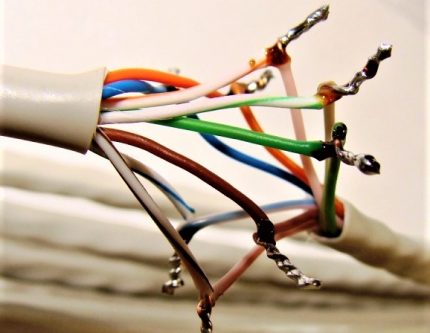
Instructions for soldering a network cable:
- We remove the external insulation from both cable segments. You can not cut it, but cut it along and bend it for a while, so that later it can be returned to its place.
- We disassemble the pairs of conductors, we clean from isolation. It is better to use a stripper, as a knife or wire cutters can damage the veins.
- We twist pairs of identical conductors of both cables. They can be easily identified by the color of the insulation. We cut off the excess.
- We solder the twisted wires: heat - apply solder. We make sure that it is evenly distributed over the place of twisting. The result should be a solid, inextricable connection.
- First, we make insulation of each soldered wire separately, then all together - we wrap the switching place with a dense layer of electrical tape. We make sure that there are no bare areas left.
It is not recommended that the cords connected in this way be brought out into the street or placed in rooms with high humidity.
If this is still necessary, then the repaired section of the wire should be sealed as much as possible. For protection, for example, polymer flexible hoses can be used.
Option # 3 - using a terminal
As in power electrics, in a low-current one they use for connecting wires special terminals. They can be found in online stores called “adhesive tape locks”. These are compact plastic connectors with metal contacts.
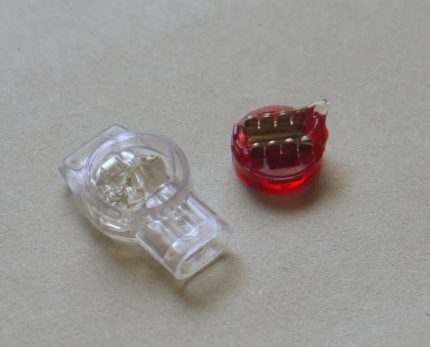
The advantage of using terminals is that you do not need to spend time thoroughly stripping the wires or winding the connection point with electrical tape. But this is provided that the switched area will be located in the protected area - in the wall, in the box or baseboard.
Step-by-step crimping instructions:
The finished connection resembles a garland - the terminals stick out in all directions, they cannot be compactly hidden.
But you should not worry about the tightness of the connections. Despite the appearance, the switching is reliable, and the cable will work in much the same way as the analogue restored by twisting.
Option # 4 - Twisted Pair Connector
For switching two patch cords there is a simple and affordable way even for a child - connecting a small device in the form of a box. No special names were invented for him; in network equipment stores, he is called “connector”, “connector 8P-8C”.
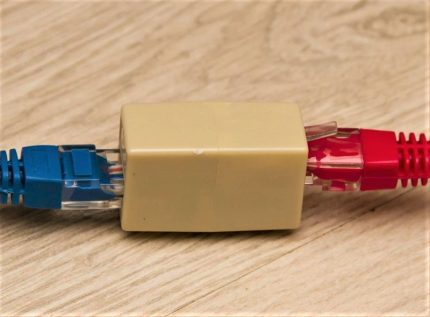
However, there is one condition: to connect two segments into one, in addition to the adapter, connectors are needed - computer plugs for switching.
That is, the connector can be used if previously squeeze twisted pair.
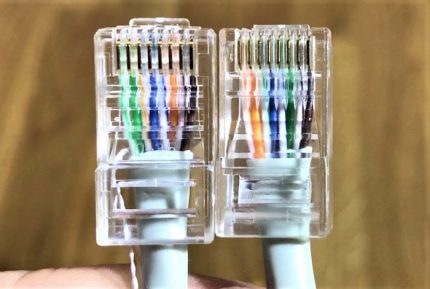
The process of lengthening the twisted pair with the help of the adapter is easy: in the connectors located on different sides of the “box”, you need to insert the patch cord connectors.
In addition to special devices for extending the Internet cable, sometimes they use equipment that has a completely different purpose - for example, external power sockets or internal working parts of built-in sockets.
Some craftsmen manage to connect hubs. This is useless, as there are simpler and easier ways described above.
Conclusions and useful video on the topic
How to crimp a cable to make a connector switch:
Video instruction on twisting:
The recommendation how to quickly build up a twisted pair - patchcord:
The simplest way that does not require a special tool and skills is twisting. However, according to experts, it is absolutely not suitable for high-speed data transfer.
If you want to get a really high-quality connection, we recommend that you purchase a factory-made wire and connect it to the devices in accordance with the instructions and safety standards.
Is there anything to supplement, or have questions about connecting a twisted pair cable to each other? You can leave comments on the publication, participate in discussions and share your own experience in building a network cable. The contact form is located in the lower block.

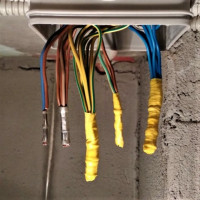 How to connect wires without soldering: the best ways and their features + installation recommendations
How to connect wires without soldering: the best ways and their features + installation recommendations 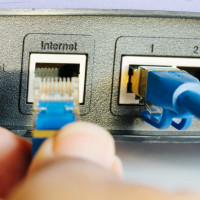 Cable for the Internet: varieties, device + what to look for when buying wire for the Internet
Cable for the Internet: varieties, device + what to look for when buying wire for the Internet 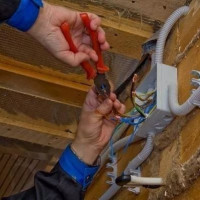 Electrician in a wooden house: diagrams + installation instructions
Electrician in a wooden house: diagrams + installation instructions 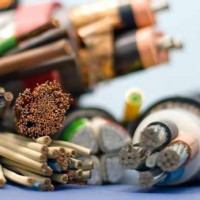 Wire cross section for home wiring: how to correctly calculate
Wire cross section for home wiring: how to correctly calculate 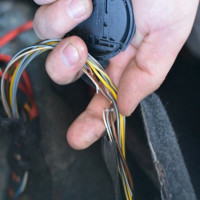 How to find a wire break in a wall: an overview of ways to detect and repair a break
How to find a wire break in a wall: an overview of ways to detect and repair a break 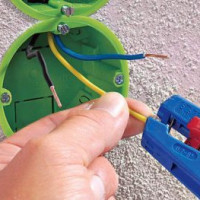 Stripping wires from insulation: methods and specifics of removing insulation from cables and wires
Stripping wires from insulation: methods and specifics of removing insulation from cables and wires  How much does it cost to connect gas to a private house: the price of organizing gas supply
How much does it cost to connect gas to a private house: the price of organizing gas supply  The best washing machines with dryer: model rating and customer tips
The best washing machines with dryer: model rating and customer tips  What is the color temperature of light and the nuances of choosing the temperature of the lamps to suit your needs
What is the color temperature of light and the nuances of choosing the temperature of the lamps to suit your needs  Replacement of a geyser in an apartment: replacement paperwork + basic norms and requirements
Replacement of a geyser in an apartment: replacement paperwork + basic norms and requirements
In vain you are so distrustful of twisting. If everything is done carefully, a completely reliable and working connection is obtained. In any case, it is no worse than connecting to a connector. And if for external insulation to use not an insulating tape, but as well as on conductors, heat shrink (preferably in the color of the wire), then it turns out beautifully. And the connection is almost imperceptible.
No, everything is written correctly about twisting. It must be understood that not every layman can adequately do it. They wrap it weakly, spit on the insulation, over time the twist also loosens up and starts to warm up.
Good afternoon, Gleb.
Please note, twisted pair is not a turn of speech. For example, start reading “Low-current systems of buildings and structures” - you will discover a lot of nuances of laying low-current wires, cables. The connection is twisted, I think the nightmare of a low-voltage installer. Even if you comment on the picture under “Option # 1”, then I will send you to paragraphs 2.1.21 ~ 2.1.23 of the PUE - I attached a screenshot so that they would not be searched.
And about twisting - there is GOST 10447-80, which defines the technology of testing the wire for twisting the test sample around a cylindrical mandrel. Why is this needed? - I answer: when winding and when twisting the wires, a change in the structure of the metal, a change in its resistance, is observed. I hope you should not decipher the consequences?
Those.In your opinion, Vasily - laying external wiring around the house on insulators (when curling with such a beautiful pigtail) is GOST prohibited?
Cable extension may be necessary in many cases - rearrangement, connection of additional devices. Make it easy. The only thing - I do not recommend using twist when connecting any wires. This is a temporary connection method, when there is nothing at hand, and it has many disadvantages. In the end, it’s not so difficult to arm yourself with a soldering iron and make a normal connection.
Is it possible in this way: (twisting, soldering) to connect not two, but more cables. For scrolling Internet cables in rooms from a central cable?
No.